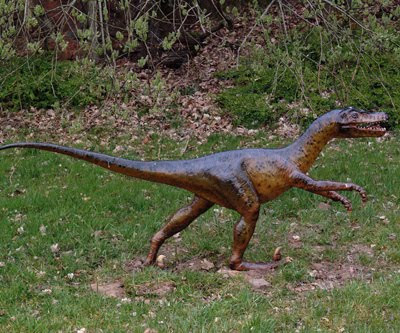
Dromaeosaurids are known throughout the Cretaceous and from North and South America, Europe, Asia, Africa, and Madagascar.
Basal dromaeosaurs (Unenlagiinae and Microraptorinae) include some crow- to turkey-sized taxa: Rahonavis of the Late Cretaceous of Madagascar (and initially thought to be a bird); Microraptor of the Early Cretaceous of China (the first eumaniptoran for which the tail feathers were known); long-snouted Buitreraptor of Late Cretaceous Argentina; and others. Not all of these were small, however. One of the most unusual of these basal dromaeosaurids is giant Austroraptor of the mid Late Cretaceous of Argentina: a long-snouted, short-armed polar bear-sized unenlagiine.
The more derived dromaeosaurids (Saurornitholestinae, Deinonychus, Velociraptorinae, and Dromaeosaurinae) form a group called Eudromaeosauria. These were coyote-to-grizzly bear sized. Well-studied examples include coyote-sized Velociraptor of the Late Cretaceous deserts of Mongolia; wolf-sized Deinonychus of the Early Cretaceous of western North America; lion-sized Achillobator of mid-Late Cretaceous Asia; and grizzly-sized Utahraptor of the Early Cretaceous of western North America, at present the largest known eumaniraptoran.
Dromaeosaurid caudals were more tightly interlocked than in typical theropods, and in microraptorines and eudromaeosaurs extensions from the chevrons and neural arches grew extremely long. The tail was thus an extreme dynamic stabilizer.
Some basal dromaeosaurids had elongate metatarsi (indeed, they have a primitive form of the arctometatarsus), but the majority had relatively short stout metatarsi and tibiae. This suggests that they had sacrificed speed, perhaps for agility (better able to turn quickly while pursuing prey or escaping predators, especially with the help of the stiffened tail). Despite certain books and movies to the contrary, the dromaeosaurids show no signs of being speed specialists.
While the small primitive forms may have eaten small prey (skewering it with the sickle claw in the manner of modern secretary birds, perhaps), the larger forms were predators of dinosaurs. The "Fighting Dinosaurs" specimen of Velociraptor shows it in combat with Protoceratops, the hands used to grasp the head of the herbivore while the sickle claw was ripping into the throat: very similar to the attacks used by large cats. Some (contraversial) evidence suggest that Deinonychus may have attacked the much larger iguanodontian Tenontosaurus in groups (packs or mobs).
Note that the sickle claw may have also been used to climb: either up trees, or up the sides of victims! Additionally, they may have been used to pin smaller prey down on the ground while the jaws and hand claws were used to kill it.

At least some of the early forms may have had limited flight capability: indeed, they show somewhat better flight adaptations than Archaeopteryx! The majority of dromaeosaurids, however, probably lived their lives on the ground (although hiding/sleeping in the trees may have been possible, especially for juveniles).
In the Early Cretaceous dromaeosaurids were major mid-sized predators, and in the deserts of Late Cretaceous Asia they were among the largest carnivorous dinosaurs present. However, with the rise of the tyrannosaurids large-bodied dromaeosaurids disappear in the Northern Hemisphere, and the Late Cretaceous dromaeosaurids of Asia and North America were fairly small animals.

No comments:
Post a Comment